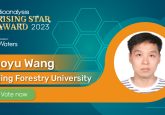Bioanalysis Rising Star Award finalist: Ruixuan Gao
Nominated by: Stephanie Cologna, University of Illinois Chicago (IL, USA)
Supporting comments:
“I am delighted to support Dr Ruixuan Gao’s consideration for a Rising Star Award. As Dr Gao has outlined, his contribution to bioanalytical science is on the upswing. Bringing together his training in synthetic chemistry and high-resolution microscopy, Dr. Gao is now positioned to be a leader in super-resolution/expansion microscopy of biological systems with a focus on neurobiology and neuroscience. With the ever-growing need for new and improved technologies and analytical solutions to solve biological problems, I consider Dr Gao to be well-positioned to be highly successful in his research endeavors. As with many young scientists who began their independent positions during the pandemic, Dr Gao faced unique challenges but has been able to smoothly transition. In his short time at the University of Illinois Chicago (since Aug 2021), he has successfully established his research group and began developing the next-generation bioanalytical methods. The research projects Dr Gao is tackling are difficult – but critical for measurement science. His achievements will span beyond his independent group and will enable researchers across the world to see biological processes, which have never been reported.”
Describe the main highlights of your bioanalytical work
My research focuses on developing bioanalytical tools that can map and track endogenous biomolecules and chemical species in biological specimens at the molecular scale. My lab is particularly interested in applying such tools to study neural systems, such as the ultrastructure of chemical synapses, connectivity of neural circuits and pathophysiology of neurodegeneration and mental illness.
Towards this goal, I recently helped to establish the chemical and biological backbone of a new fluorescence imaging method called expansion microcopy. In this method, biomolecules of interest are anchored to a swellable hydrogel and then physically pulled away by the expanding hydrogel network. This expansion process allows the anchored molecules to be imaged at the nanoscale on a conventional microscope.
In parallel, I co-developed a scalable imaging and analysis method called expansion lattice light-sheet microscopy. By combining tissue expansion and state-of-the-art imaging/image analysis tools, we were able to demonstrate spatial analysis of synapses and neurites across an entire mouse cortical column and fly brain at 60-90 nm resolution. Further, we were able to perform similar imaging on clinical samples, including nanoscale visualization and analysis of podocyte foot processes in a complete human kidney glomerulus section.






